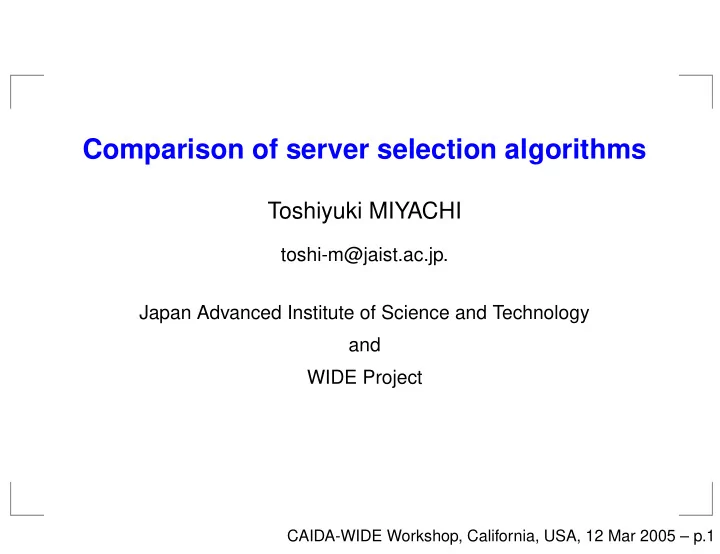

Comparison of server selection algorithms Toshiyuki MIYACHI toshi-m@jaist.ac.jp. Japan Advanced Institute of Science and Technology and WIDE Project CAIDA-WIDE Workshop, California, USA, 12 Mar 2005 – p.1
Background There are many server-client model communications With these communications, clients have to select its server There are some server selection algorithms Best server selection Uniform(Random) server selection Reciprocal to cost server selection Best server selection is very popular but it is unstable if there are 2 servers which cost is almost same from clients, these clients always choose one server Then the cost to the server is changed, many clients choose the other server Using uniform server selection is very stable but it is not efficient CAIDA-WIDE Workshop, California, USA, 12 Mar 2005 – p.2
Motivations We want to know server and node behaviors with these algorithms when the cost to server from clients is changed And then we will consider better algorithms In this presentation I’ll talk about the simulation of these ex- isting server selection CAIDA-WIDE Workshop, California, USA, 12 Mar 2005 – p.3
The simulation topology There are 510 nodes and 60 servers CAIDA-WIDE Workshop, California, USA, 12 Mar 2005 – p.4
Rules of making topology(1/2) Selecting a node as a parent and connecting a new node to the parent The parent node is selected at the probability of proportion to the number of its edges The edge cost is 10 Placing a server On the node with the most a lot of edges Every 10 nodes server node client node CAIDA-WIDE Workshop, California, USA, 12 Mar 2005 – p.5
Rules of making topology(2/2) A server splits when its clients number become over 20 (In making topology phase, clients chooses its server using best server selection ) Connecting servers 2 servers are selected at the probability of proportion to the number of its edges Every 100 nodes CAIDA-WIDE Workshop, California, USA, 12 Mar 2005 – p.6
The simulation Picking up one server at random each step Changing the cost between the server and its binded nodes The cost is chosen at random between 1-40 All nodes send 100 queries to its server each step Then restore the cost to the initial condition server node change cost of this edge client node CAIDA-WIDE Workshop, California, USA, 12 Mar 2005 – p.7
Average cost and maximum cost CAIDA-WIDE Workshop, California, USA, 12 Mar 2005 – p.8
Server load: Best selection(1/2) CAIDA-WIDE Workshop, California, USA, 12 Mar 2005 – p.9
� Server load: Best selection(2/2) An edge from a server to its binded cost is changed 29 10 Another server’s load is highly increased The server’s load is reduced green:0-599 yellow:600-1099 orange:1000-1599 red:1600- CAIDA-WIDE Workshop, California, USA, 12 Mar 2005 – p.10
Server load: Uniform selection CAIDA-WIDE Workshop, California, USA, 12 Mar 2005 – p.11
� Server load: Reciprocal selection( ) CAIDA-WIDE Workshop, California, USA, 12 Mar 2005 – p.12
� � Server load: Reciprocal selection( ) CAIDA-WIDE Workshop, California, USA, 12 Mar 2005 – p.13
Server load: Reciprocal selections There are no server which have many clients Not so big fluctuation, if any edge cost is changed Between best server selection and uniform server selection CAIDA-WIDE Workshop, California, USA, 12 Mar 2005 – p.14
Comparison of server selection algorism Using best server selection, when cost to big server is changed, the influence is very big Using uniform server selection, the server load is very stable, but its efficiency is bad Using kind of reciprocal server selection, the performance is middle of these algorithms responce time Uniform Reciprocal Best Stalability CAIDA-WIDE Workshop, California, USA, 12 Mar 2005 – p.15
Future work More simulations Simulation results are influenced by the topology, we consider the relationship between topologies and simulation results If server cost is proportional to its load, I will get another type of simulation result New server selection algorism Categorize topologies and try suitable server selection algorithms for these topologies CAIDA-WIDE Workshop, California, USA, 12 Mar 2005 – p.16
Conclusion Measured server loads and costs from a client to its server Simple visualization of server load Using reciprocal server selection, server load and cost from client to server is not so much fluctuated Consider relationships between topologies and server selection algorism Try to find better server selection algorism for each type of topologies CAIDA-WIDE Workshop, California, USA, 12 Mar 2005 – p.17
Recommend
More recommend